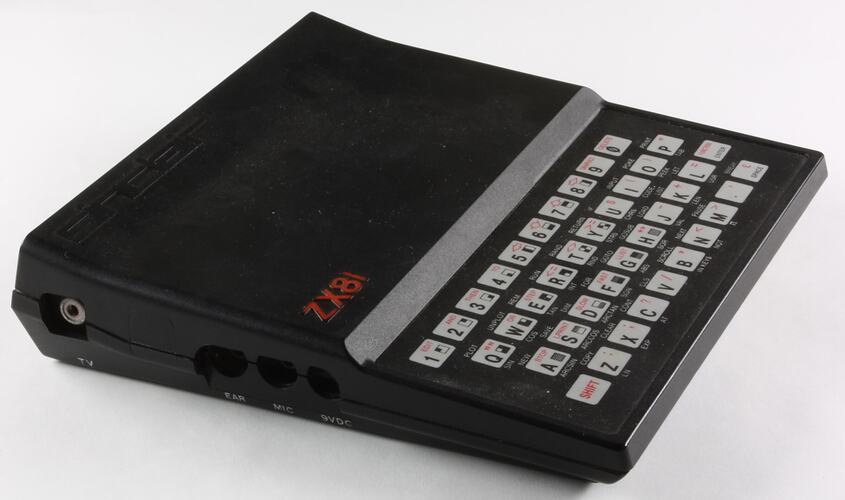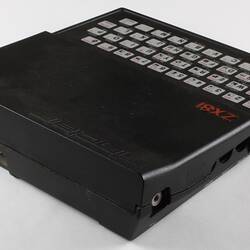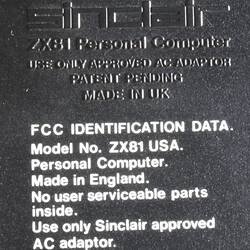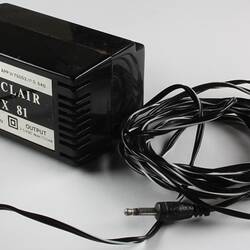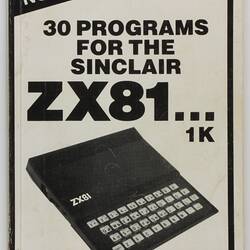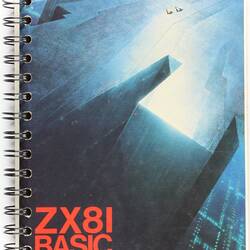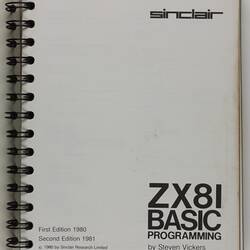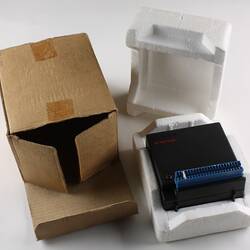Summary
Keyboard console of ZX81 computer.
Programs were loaded from a tape recorder.
Video output was to a television set, and saving and loading programs was via an ordinary home audio tape recorder to audio cassette.
The ZX81 used a membrane keyboard is a computer keyboard whose "keys" are not separate, moving parts, as with the majority of other keyboards, but rather are pressure pads that have only outlines and symbols printed on a flat, flexible surface. Very little, if any, tactile feedback is felt when using such a keyboard, and error-free blind typing can be difficult.
Also donated:
* a ZX 16K RAM expansion pack to increase memory capacity of the ZX81 home computer. It provided 16 KB of extra RAM. The built-in memory of the ZX81 did not go very far, so the pack plugged into the main circuit board expansion bus edge connector. Expansion packs were notorious for their loose and wobbly connection to the main board. A nudge or jolt usually resulted in a crash with the loss of hours of programming. People used Blu Tack, tape, and other adhesives to prevent wobble.
* Manual with listings of thirty programs that can be run on the ZX81 home computer. It is addressed to the person who also wants to learn how to program. It has a friendly inviting style.
It was published by Melbourne House of South Melbourne. There is a publisher's note signed by Alfred Milgrom. Alfred Milgrom has played a significant role in software development over the years.
* Basic Programming Manual dealing with all aspects of the ZX81 home computer - installation, programming and running programs. It is addressed to the novice but also caters for the initiated
The equipment was owned by an avid collector of personal computers and associated peripheral and technical data. The collector belonged to several computer clubs. He died unexpectedly after an illness so he made no arrangements for the disposal of his collection. Two friends were asked to dispose of the collection - it took them three days to clear it out of the house. Most items went to other collectors.
Description of Content
Manual dealing with all aspects of the ZX81 home computer - installation, programming and running programs. It is addressed to the novice but also caters for the initiated
Physical Description
The case is black, with a membrane keyboard membrane keyboard. Sinclair logo impressed on panel. Accompanying the computer are a manual with 30 Programs for the Sinclair ZX81, a Basic Programming Manual, a power adaptor, a connector and a Memory Expansion Pack. Manual '30 Programs':Bound booklet with off-white front cover. ZX81 illustration on front cover below text. Manual - Basic Programming: Ring bound booklet with bluish front cover. Adaptor: Australian mains pins. Jack plug connector with long black/white cord. Connector: Single lead with two jack pug connecotrs at each end. One lead has a yellow band around the end of the jack plug at each end. Expansion Pack: Black almost rectangular box with blue circuit connector at front. Also moulded polystyrene packaging (Sinclair logo impressed on surface of one part) and plain brown cardboard box
Significance
The Sinclair ZX81 home computer, released by the UK firm Sinclair Research in 1981, was part of the push to develop a mass market for cheap computers. This push led to a boom in companies producing hardware and softaware, which still continues in 2008. It had a very small component count.
'It was a real computer, you could do calculations, it was programmable, you could do lots of things with it - it was in every way a real computer at a very low price.' Interview with A. Tony Tebby of Sinclair Research, 24 October 1985.
'The secret ... of the lower price and improved performance of the ZX81 over the ZX80 is a new bipolar chip designed by Sinclair . . . The single integrated circuit concentrates 18 of the 21 chips of the ZX80, so that the ZX81 comes with only four chips . . . The new chip . . . eliminates the need for the processor to drive the TV display, thus causing the screen to go blank whenever processing was being done. The ZX81 processes in two modes: normal, where the display is constantly on, and fast, where processing takes place at four times the speed but data is only displayed either at the completion of a program, when input data is awaited, or during a pause.' (Infomatics, 16 March 1981.)
More Information
-
Collecting Areas
-
Acquisition Information
Donation from Helen Olsen, Henry Olsen, 19 Feb 2008
-
Manufacturer
Sinclair Research Ltd, Cambridge, Cambridgeshire, England, Great Britain, 1981
-
Past Owner
Alfred Milgrom, Melbourne, Greater Melbourne, Victoria, Australia, 1980
-
Inscriptions
Console: 'ZX 16K RAM' printed in red just above QWERTY style keyboard. Manual: '30 Programs': Printed, cover, black ink: "NOT ONLY / 30 PROGRAMS FOR THE SINCLAIR / ZX81 . . . 1K" Manual - Basic Programming: Printed, front cover, red ink: "Sinclair / ZX81 Basic Programming'. Extensive text within. Adaptor: Metal label on top surface includes the words 'SINCLAIR ZX81' Expansion Pack: Sinclair logo impressed on front above 'ZX 16K RAM' printed in red.
-
Model Name or Number
-
Brand Names
-
Classification
-
Category
-
Discipline
-
Type of item
-
Overall Dimensions
165 mm (Width), 174 mm (Depth), 38 mm (Height)
Overall Dimensions of console.
-
References
[Link 1] accessed 10 July 2008 [Link 2] accessed 10 July 2008 [Link 3] accessed 15 July 2008
-
Keywords
